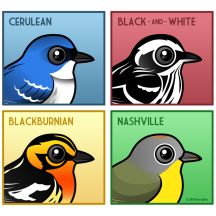Also known as: Calaveras Warbler, Gray-headed Warbler
The Nashville Warbler is a small, energetic bird with a bright yellow underbelly and an olive green back. It features a distinctive gray head with an incomplete white eye-ring, giving it a sharp, alert appearance. Males and females look similar, though males may display slightly brighter colors during the breeding season.
This warbler is particularly active, often seen flitting through shrubs and low branches in search of insects and spiders. Its song is a rapid mix of high-pitched notes, which it uses to defend its territory and attract a mate during the breeding season.
The Nashville Warbler breeds in northern parts of the United States and Canada, particularly favoring young deciduous forests and mixed woodlands. They construct their nests on the ground, hidden among dense vegetation, which provides protection from predators.
In winter, the Nashville Warbler migrates to the southern United States and Central America, where it can be found in a variety of forested and scrubby habitats. The Nashville Warbler was named in 1811 by ornithologist Alexander Wilson, who first recorded the bird for science. Although the bird was 'discovered' by Wilson in Nashville, Tennessee, the bird is only found there during migration.
ズアカアメリカムシクイ (zuakaamerikamushikui)








































